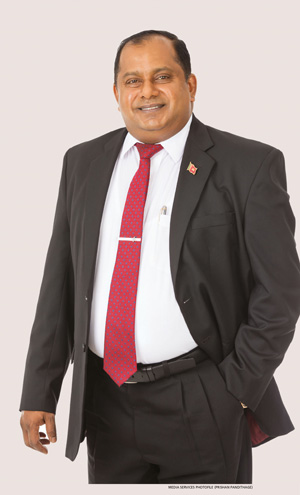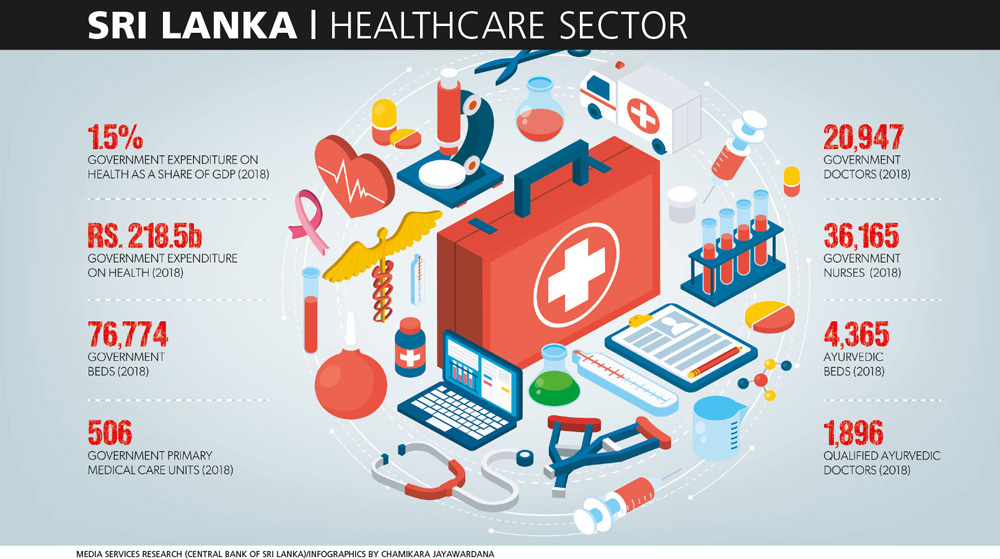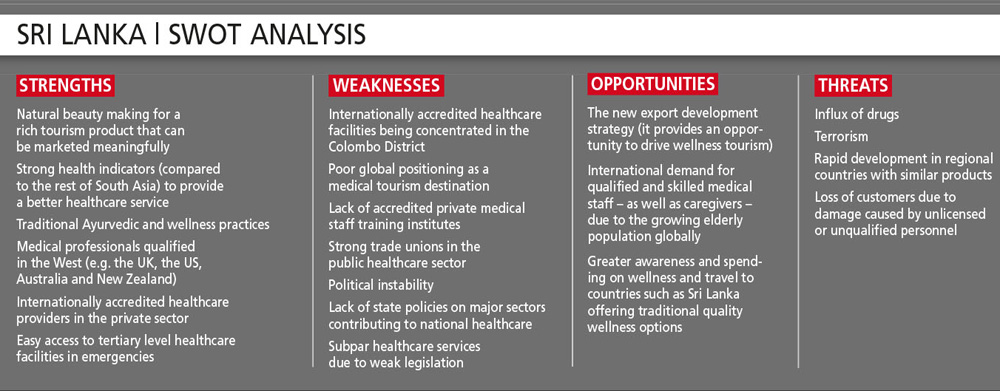HEALTHCARE SECTOR
HEALTH IS WEALTH
Compiled by Yamini Sequeira
BRIGHT MEDICAL PROGNOSIS
Dr. Prasad Medawatte asserts that Sri Lanka’s healthcare can take on the world
Increasing demand for private healthcare is driven by Sri Lanka’s ageing population and the rising incidence of noncommunicable diseases (NCDs), which the nation’s state hospitals aren’t fully equipped to handle. Furthermore, rural income levels have increased at a more rapid pace than in urban areas in recent years. A decline in the use of outpatient and inpatient care in state hospitals also indicates a shift by rural populations to private healthcare, according to Fitch Ratings.
Sri Lanka’s per capita healthcare spend is substantially below the average for higher middle income countries (although it is above our South Asian peers), highlighting the potential for growth over the medium to long terms.
Commenting on the state of play in Sri Lanka’s healthcare sector, Dr. Prasad Medawatte says: “The private healthcare sector is mainly restricted to Colombo and the Western Province with newer service providers coming up. Existing major hospitals have increased their capacity to some extent and the private healthcare market is now quite saturated.”
Heating the competitive landscape further, the state sector has taken steps to develop services and facilities at so-called ‘government hospitals.’ The majority of patients are filtered from the state sector into private healthcare, which perhaps is why government hospitals are streamlining their services to preempt patients seeking private healthcare.
GROWTH POTENTIAL Despite the competition, the private healthcare sector witnessed steady growth of seven to eight percent last year. “As Sri Lanka doesn’t have a health insurance dominated market, private healthcare providers must look to foreign markets for medical tourists,” Medawatte asserts.
“The government in collaboration with the Export Development Board (EDB) launched medical tourism initiatives under the National Export Strategy (NES) initiated last year – and the private sector is working on the steering committee for medical tourism. We are trying to position Sri Lanka as a destination for medical tourism by targeting services such as cosmetic and orthopaedic surgeries, as well as dental care,” he elaborates.
Medawatte reveals that marketing efforts in foreign markets have proved to be positive with a healthy response coming from the Maldives, the Seychelles, the Middle East, Europe, India and China. And he notes that visitors are also attracted by Sri Lanka’s overall tourism product.
According to him, key strategies to attract foreign medical tourists include global certifications “so that we can then ensure patient safety by following international standards.” Moreover, since Sri Lankan health professionals are trained in reputable countries such as the UK, the US and Australia, they’re internationally qualified.
“Therefore, we must position Sri Lanka’s health facilities by increasing awareness of the standards of the international facilities and professionals we offer. We cannot do that alone, which is what the government is gearing up for especially through the EDB with its new export development strategies,” Medawatte remarks.
In terms of growing medical tourism, the numbers have increased over the previous year based on the individual hospitals taken statistically. Due to congestion in the state healthcare sector, those who want more privacy and comfort are opting for private sector healthcare.
RESIDUAL CHALLENGES Commenting on sector related issues, Medawatte observes: “There is a huge vacuum in terms of technical staff including nurses and doctors in the private healthcare sector, because the government offers attractive remuneration and pension schemes, as well as housing and vehicle loans to doctors.”
He adds: “Some universities conduct technical training courses but no private institutions are permitted to do so except pharmacies. So we do need more technical staff.” Apart from that, the government has taken some positive steps with universities introducing paramedical courses, which help produce more technical staff.
In Sri Lanka, the government is producing medical professionals so the annual intake of such students as well as related facilities is increasing by the year. A huge demand exists for more qualified doctors in the state medical sector.
Medawatte concedes that unfortunately, Sri Lanka does not have a national health insurance scheme as a result of which this task is fulfilled by private sector companies. He posits: “In the UK or other Western countries, health insurance is free. Hopefully, the government will work on something similar in the long run.”
SECTOR WISH LIST Speaking aspirationally, Medawatte says that “in the private healthcare sector, we have to consider becoming more specialised instead of operating as a general tertiary care hospital. By specialising, we can not only maintain the highest standards and expertise in that field but the entire sector can be marketed better overseas too.”
In the meantime, the government has been developing capacity particularly in critical areas such as renal care, cardiology, heart transplants and chemotherapy.
With respect to weak areas in the healthcare sector that must be strengthened, Medawatte declares: “We’re not geared to handle the major area of oncology, and service equipment and drugs are very expensive. So the private sector’s investment in oncology is low. If we have one private hospital to handle such services, it will definitely be a benefit.”
In the private healthcare sector, hospitals mostly treat cardiac and renal cases. The government, health ministry and private education systems are conducting more medical exhibitions and events, and raising awareness and knowledge about such diseases. This is complemented by events such as World Heart Day, and awareness about cancer prevention and so on.
CRITICAL MASS In the absence of a holistic vision for the future of the healthcare sector, operators in the private healthcare domain focus on individual growth. But the government seems to be introducing strategic national policies to position Sri Lanka as a destination for medical tourism, which bodes well for the sector.
Working in unison on a future plan for the healthcare sector – while individually introducing advanced medical facilities and enhancing patient handling skills – will create more trust among the sector and community, Medawatte asserts.
In this context – and while facilitating the growth of private sector services – regulation of the private healthcare sector is vital to ensure quality standards in service delivery, healthy competition, competitive pricing and prevention of patients being exploited by private healthcare providers.









